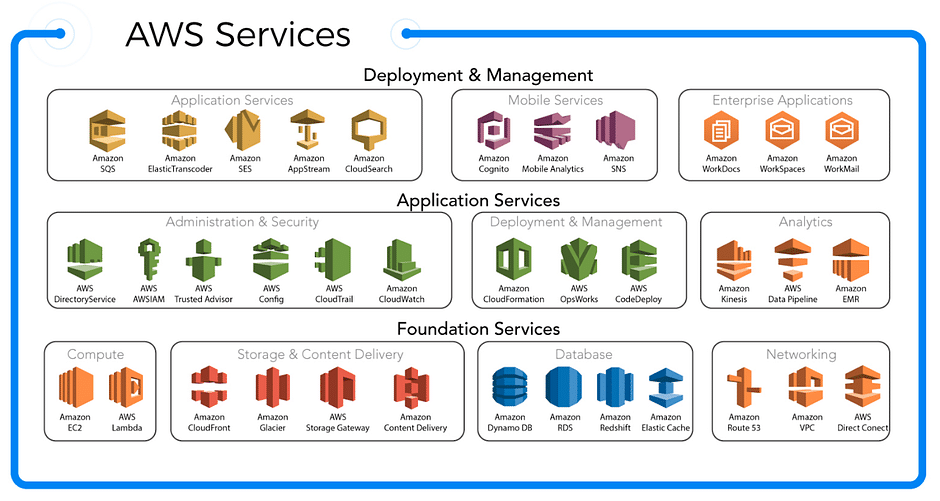What is cloud computing?
Cloud computing is the on-demand delivery of IT resources over the Internet with pay-as-you-go pricing. Instead of buying, owning, and maintaining physical data centers and servers, you can access technology services, such as computing power, storage, and databases, on an as-needed basis from a cloud provider like Amazon Web Services (AWS).
Types of cloud computing
The three main types of cloud computing include Infrastructure as a Service, Platform as a Service, and Software as a Service. Each type of cloud computing provides different levels of control, flexibility, and management so that you can select the right set of services for your needs.
Cloud computing models
Although definitions vary from company to company, traditionally there have been three main models for cloud computing. Each model represents a different aspect of cloud computing.
Infrastructure as a Service (IaaS)

IaaS contains the basic building blocks for cloud IT. It typically provides access to networking features, computers (virtual or on dedicated hardware), and data storage space. IaaS gives you the highest level of flexibility and management control over your IT resources. It is most similar to the existing IT resources with which many IT departments and developers are familiar.
Platform as a Service (PaaS)

PaaS removes the need for you to manage underlying infrastructure (usually hardware and operating systems), and allows you to focus on the deployment and management of your applications. This helps you be more efficient as you don’t need to worry about resource procurement, capacity planning, software maintenance, patching, or any of the other undifferentiated heavy lifting involved in running your application.
Software as a Service (SaaS)

SaaS provides you with a complete product that is run and managed by the service provider. In most cases, people referring to SaaS are referring to end-user applications (such as web-based email). With a SaaS offering, you don’t have to think about how the service is maintained or how the underlying infrastructure is managed. You only need to think about how you will use that particular software.
IT deployment models
Cloud
A cloud-based application is fully deployed in the cloud and all parts of the application run in the cloud. Applications in the cloud have either been created in the cloud or have been migrated from an existing infrastructure to take advantage of the benefits of cloud computing. Cloud-based applications can be built on low-level infrastructure pieces or can use higher-level services that provide abstraction from the management, architecting, and scaling requirements of core infrastructure.
Hybrid
A hybrid deployment is a way to connect infrastructure and applications between cloud-based resources and existing resources that are not located in the cloud. The most common method of hybrid deployment is between the cloud and existing on-premises infrastructure, to extend and grow an organization’s infrastructure into the cloud while connecting cloud resources to internal system. For more information on how AWS can help you with your hybrid deployment, visit Hybrid Cloud with AWS.
On premises
Deploying resources on premises using virtualization and resource management tools does not provide many of the benefits of cloud computing, but it is sometimes sought for its ability to provide dedicated resources. In most cases this deployment model is the same as legacy IT infrastructure while using application management and virtualization technologies to try and increase resource utilization.
AWS Global Infrastructure
The most secure, extensive, and reliable Global Cloud Infrastructure, for all your applications
37
Regions
launched Regions each with multiple Availability Zones
117
Availability Zones
The AWS Cloud spans 117 Availability Zones within 37 Geographic Regions, with announced plans for 13 more Availability Zones and 4 more AWS Regions in New Zealand, the Kingdom of Saudi Arabia, Chile, and the AWS European Sovereign Cloud.
700+
POPs
CloudFront POPs and 13 Regional edge caches
43
Local Zones
Local Zones 31 & Wavelength Zones for ultra-low latency applications
🌍AWS Regions and Availability Zones (AZs)
The foundation of the AWS Cloud Infrastructure lies in its Availability Zones and AWS Regions.

- An AWS Region corresponds to a geographical area housing multiple Availability Zones.
- Each Availability Zone comprises one or more separate data centers, each equipped with sufficient power, network setup, and reliable connections within distinct zones.
🟩 1. Region:
An AWS Region is a geographic area (like a country or part of a continent) that contains multiple isolated data centers.
- Each region is physically separate from others.
- Examples:
us-east-1→ North Virginia (USA)ap-south-1→ Mumbai (India)eu-west-1→ Ireland
🔑 Why Regions matter:
- You choose regions based on proximity to users, compliance, latency, or cost.
- Data does not automatically replicate across regions.
🟨 2. Availability Zone (AZ):
An Availability Zone is one or more data centers within a Region that are isolated from failures but connected with low-latency links.
- Each region has at least 2–3 AZs (some have more).
- AZs are labeled
a,b,c, etc., like:us-east-1a,us-east-1b, etc.
🔑 Why AZs matter:
- You deploy across multiple AZs for high availability.
- If one AZ fails (e.g., due to power outage), others keep running.
AWS Benifits
Consumers choose AWS to enhance agility, reduce complexity, and mitigate
risks, as it provides a wide range of services that can be easily configured.

AWS Core Services
Amazon offers various services that are broadly categorized into the following categories:
Compute Storage, Database, Analytics, Networking, Mobile, Developer tools, IoT, Security, Management tools, Enterprise applications





